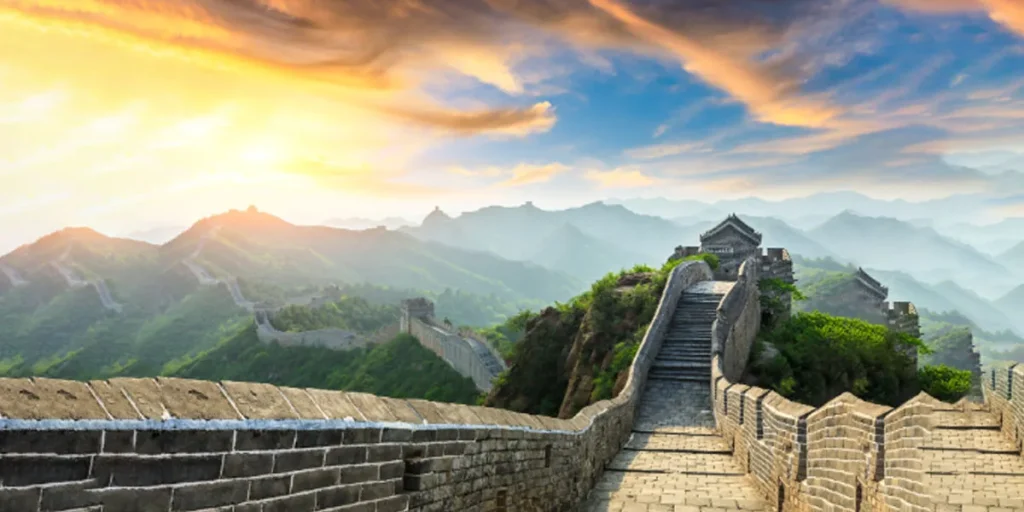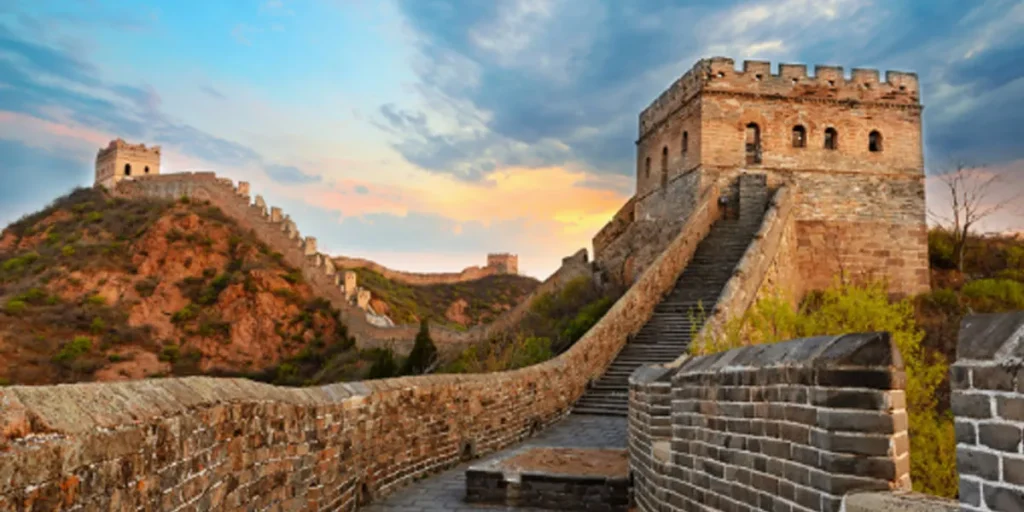The Great Wall of China averages 30 feet in width. Its narrowest point is around 15 feet across.
Spanning over 13,000 miles across northern China, the Great Wall remains one of the world’s most awe-inspiring historic structures.
Constructed over centuries and known for its architectural magnificence, the Great Wall was originally built as a defense system to ward off invasions.
Today, it stands as a symbol of the enduring strength and complexity of Chinese civilization.
Travelers from around the globe visit this UNESCO World Heritage site to witness its grandeur and to walk along sections that have stood the test of time.
This wall not only represents a triumph of engineering but also serves as a cultural touchstone, illustrating the rich history and tenacity of the people who built it.

Scale Of The Great Wall
Spanning vast distances across China’s landscapes, the Great Wall stands as a testament to ancient engineering.
Its scale, both in length and width, varies significantly, offering a glimpse into China’s historical defense strategies.
Visitors worldwide marvel at its majestic expanse, a structure woven into the fabric of China’s rich history.
Measuring The Breadth
The width of the Great Wall is far from uniform. Aspiring to understand its dimensions requires examining sections measured meticulously by historians and archaeologists.
Typically, the wall’s top width accommodates five horsemen side by side, revealing insights into its strategic use.
| Section | Width at the Top (meters) | Width at the Base (meters) |
|---|---|---|
| Badaling | 5.8 | 6.5 |
| Jinshanling | 5.0 | 6.2 |
| Mutianyu | 4.0 | 4.5 |
Variations Along The Expanse
One might assume the Great Wall shares a consistent design. Yet, this iconic structure displays a unique character as it snakes over mountains and deserts.
Factors such as geography and resources influenced its construction, leading to different architectural choices.
- In mountainous areas, walls are generally narrower due to the rugged terrain.
- In contrast, significantly wider sections are seen in flatter areas, making it a formidable barrier against invaders.
- Watchtowers and barracks add to the width in strategic locations, accommodating soldiers and supplies.
Such variation underpins the adaptability of ancient Chinese designers, reflecting their profound understanding of varied landscapes.
This feature enhances the marvelous legacy of the Great Wall, capturing the imagination of those who visit and scholars who study it.
Historical Construction Techniques

The Great Wall of China’s grandeur is not just a result of its length but also its construction prowess.
Unique techniques developed over several dynasties contributed to its massive scale and varying widths.
Materials Used In Different Sections
The materials for building the Great Wall varied greatly due to geographical locations and resource availability. This diversity directly influenced the wall’s width in different sections.
- Rammed Earth: Used during the Qin Dynasty, providing a base width of up to 5 meters.
- Stones: Employed in mountainous regions, these sections measured up to 6 meters wide.
- Bricks: Ming Dynasty innovations led to a standardized size, offering uniformity and facilitated repair.
Impact On Wall Width
Different construction techniques brought variations in the wall’s width. Strategic decisions often determined these fluctuations.
| Section | Material | Width Range |
|---|---|---|
| Northern Borders | Stone | 6-7 meters |
| Eastern Plains | Rammed Earth | 5-6 meters |
| Ming Dynasty Stretches | Bricks and Stones | Up to 8 meters |
In regions of high threat, the wall was constructed wider for increased defense capabilities.
In more peaceful areas, the wall was narrower and more symbolic than functional.
Myths Vs. Facts
Exploring the Great Wall of China’s width reveals a fascinating story of myths vs. facts. Many stories exist about this ancient marvel.
Popular Beliefs About The Wall’s Width
Many people think the Great Wall is very wide. Some say ten horses can walk side by side on it. This is a popular image, but it’s not the same everywhere.
- Tales suggest a massive structure across its whole length.
- Width estimates vary greatly in folklore.
- Some stories exaggerate, making the Wall seem unreal.
Recorded Evidence And Studies
Actual studies of the Great Wall show different widths in different areas. Some parts are wide, some are not. Researchers have measured it to understand its true size.
| Location | Average Width |
|---|---|
| Badaling | 5 to 8 meters |
| Jinshanling | 3 to 5 meters |
| Gubeikou | 2 to 4 meters |
The wall width changes with the terrain. The most famous parts, like Badaling, are wider. These were for soldiers and horses.
Experts have used maps, drones, and lasers to measure these differences. Their results show a complex and varied structure, unlike the simple myths we hear.
Notable Narrow And Wide Sections

Exploring the Great Wall of China uncovers its majestic span, varying notably in width along its length.
Certain sections of this historical monument stand out for their unique dimensions. Let’s discover the narrow and wide sections that highlight the wall’s structural diversity and strategic engineering.
Strategic Design Choices
The Great Wall’s width was not a mere chance but a calculated strategic design. In some areas, the wall narrows significantly to serve as a natural barrier and conserve resources.
These areas include treacherous mountain ridges where the barrier function was key. In contrast, wider sections facilitated troop movements and served as garrisons.
This reflects the thoughtful planning that took centuries to perfect.
Tourist Hotspots And Their Measurements
Among the most frequented stretches are the Badaling and Mutianyu sections. Badaling, once a significant military stronghold, now sees myriad tourists.
Mutianyu, with breathtaking scenery, also captivates countless visitors. Their widths vary as follows:
| Section | Narrowest Width | Widest Width |
|---|---|---|
| Badaling | 5.5 meters | 6.5 meters |
| Mutianyu | 4 meters | 5 meters |
Other sections like Jiankou and Juyongguan show similar strategic width variations. While Jiankou’s rugged terrain led to narrower paths, Juyongguan’s importance as a fort necessitated wider wall expanses.
Each stretch of the Great Wall thus tells a unique story of ancient warfare and defense.
Preservation Efforts And Changes In Width
Over centuries, the Great Wall of China has witnessed many changes. Its width has varied due to restoration projects and natural factors.
Understanding these changes is key to protecting this monumental wonder for future generations.
Restoration Impacts
Restoration helps preserve the Great Wall. When workers rebuild parts of it, they sometimes change its width.
This can happen because modern techniques and materials differ from the originals. Restoration brings stability but also alters historical structures.
Erosion And Natural Factors
Erosion from wind and rain can wear the wall down. This causes sections to become narrower over time.
On steep slopes, landslides are dangerous for the width of the wall. Natural wear and tear show why constant care is crucial.
FAQs About the Width of the Great Wall of China
How Wide Was The Great Wall Of China?
The Great Wall of China had an average width of about 6 to 7 meters.
How Many Miles Does The Great Wall Of China Run For?
The Great Wall of China spans approximately 13,170 miles in total length.
How Many Miles Can You Walk On The Great Wall Of China?
The Great Wall of China spans over 13,000 miles, offering extensive walking opportunities for visitors.
What Is The Length And Width Of China?
China spans approximately 5,000 kilometers from east to west and 5,500 kilometers from north to south at its extreme points.
It features diverse landforms with varying widths and lengths across regions.
Conclusion
Exploring the width of the Great Wall of China reveals more than just measurements. It offers insight into the engineering prowess of ancient builders.
From the narrow pathways to the broad sections fit for defensive maneuvers, this iconic structure’s width varies significantly.
Ready to discover it for yourself? The Great Wall awaits, a testament to historical ingenuity and enduring fascination.
Resources:
https://www.nasa.gov/image-article/great-wall/
https://web.cortland.edu/wangh/project1/wall.htm
